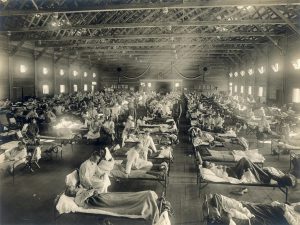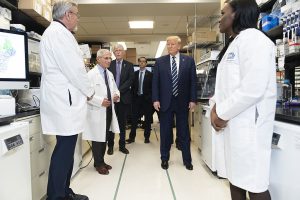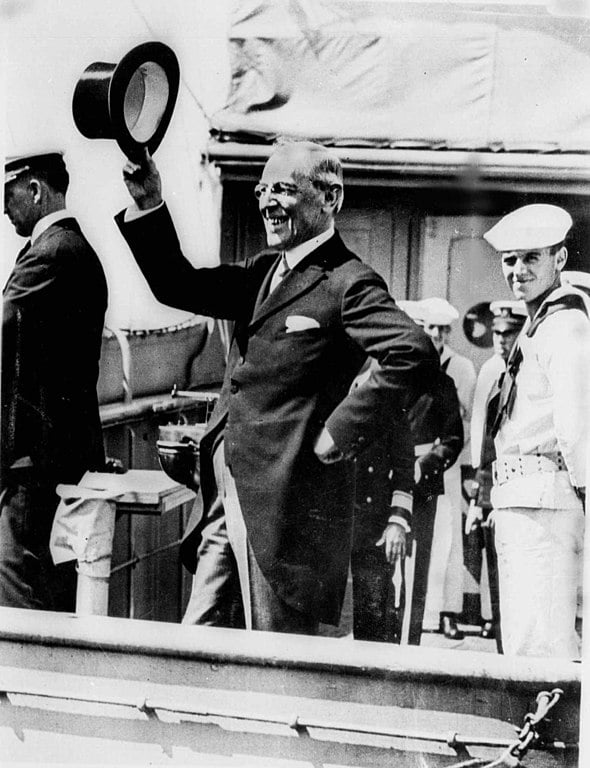Since the first novel coronavirus case was reported in the United States on January 20, more than 7.3 million Americans have contracted Covid-19.
Yesterday, President Donald J. Trump joined the pandemic’s American ranks, announcing, via Twitter, that both he and first lady Melania Trump had tested positive for the virus. It is thought he contracted it from a top White House aide.
Despite its rapid spread throughout the U.S, Trump has consistently downplayed the threat of COVID-19, mocking the mask usage of Democratic nominee Joe Biden as recently as this week’s presidential debate (Biden tested negative, yesterday).
[Wilson] became ill at a decisive moment, making the virus an insidious actor in one of the twentieth century’s most consequential episodes of great-power diplomacy.
Currently showing ‘mild cold-like symptoms’, Trump, 74, was moved from the White House to Walter Reed National Military Medical Center this morning for further treatment and monitoring.
While news of Trump’s positive test—and its ramifications—have whipped cable news and social media into a frenzy, it is not the first time a U.S. president has contracted a virus during a global pandemic.
In April 1919, President Woodrow Wilson picked up the Spanish influenza virus in Paris while participating in diplomatic discussions that would lead to the Treaty of Versailles.
Considered one of the deadliest pandemics in history, the Spanish flu killed up to 50 million and left Wilson “violently sick” at a crucial juncture in post-World War I diplomacy efforts.
“He became ill at a decisive moment,” Steve Coll wrote for the New Yorker in April, “making the virus an insidious actor in one of the twentieth century’s most consequential episodes of great-power diplomacy.”
The president gets sick
Wilson became the first sitting U.S. president to travel to Europe, when he led the American diplomatic delegation to Paris in early 1919.
A long-standing proponent of international dialogue, the 62-year-old former New Jersey governor quickly became an influential member of the post-war peace talks.
Aggrieved by towering WWI losses, French and British diplomats agitated for harsh financial and territorial penalties on Germany, while Wilson attempted to negotiate a more reasonable treaty with their defeated opponents.
On April 3 1919, Wilson “[became] ill with a fever and violent fits of coughing that left him nearly unable to breathe,” according to the Washington Post.
Dr. Cary T. Grayson, Wilson’s personal physician, later said the night “was one of the worst through which I have ever passed … I was able to control the spasms of coughing, but his condition looked very serious.”

Though his daughter, personal secretary and several members of the White House Secret Service had been infected in the U.S. the year before, Wilson struggled with the virus, greatly. There were even suggestions the peace talks themselves might be put on hold.
With Wilson quarantined in a hotel room, his aides covered up the president’s illness, blaming it on the Paris rain instead of the flu pandemic that was sweeping the world.
When Wilson returned to the negotiating table in mid-April, he lacked the confidence in energy he’d had in the preceding months. Gone was the elegant diplomat attempting to negotiate a fair and just peace; instead, Wilson was exhausted, disorientated and paranoid about the French spying on him.
Wilson would eventually give in to most of the French and British demands, allowing the Treaty of Versailles to become a notoriously harsh settlement centered around war reparations that would devastate the German economy throughout the 1920s.
“Influenza did strike Wilson,” historian John Barry wrote in The Great Influenza. “Influenza did weaken him physically … precisely at the most crucial point of negotiations.”
Comparisons and differences
There is an almost equal share of comparisons and differences between Wilson and Trump.
Yet it bears reflection that, even a century ago, as is so obvious today, the country requires a President at least as knowledgeable about and committed to sound science and public health, as to diplomacy and national defense.
Though much younger than Trump when he was infected, Wilson had a litany of underlying health issues that were exacerbated by long, tiring work on the campaign trail upon his return to the U.S.
Wilson suffered a serious stroke in October 1919, and died just five years later, aged 67.
“… [the virus] took [its] toll on him,” Howard Markel, a physician and medical historian at the University of Michigan, told CNBC yesterday.
“That can have neurologic and long-term complications. And he was already at the time traveling and living on a train and giving five to ten speeches a day. That’s not healthy.”
Like Wilson, Trump is a vigorous campaigner with several rallies over the last few fortnight. Experts say that the president’s age, gender, and weight may lead to elevated risks following his positive test.
“He is 74, he’s hefty and he’s male, and those three things together put him in a higher-risk group for a severe infection,” Dr. William Schaffner, a Vanderbilt University infectious disease specialist, told the New York Times.
“Although he is being watched meticulously and may well do fine for a few days, he is not out of the woods, because people can crash after that period of time. This is a very sneaky virus.”
Where Wilson and Trump do match up on pandemics is in the sluggishness of their leadership around them. This year, the U.S. has registered more positive COVID-19 cases and lost more lives than anywhere else in the world, during a public health response that has suffered from a lack of consistent messaging and equipment for frontline healthcare workers.
Despite suffering from it in Paris, Wilson barely addressed, publicly, the Spanish flu at home. More than 675,000 Americans would die from it.

“The federal response to the influenza outbreak in 1918 can best be described as neglectful,” author Tevi Troy wrote in his book Shall We Wake the President: Two Centuries of Disaster Management from the Oval Office.
“Hundreds of thousands of Americans died without President Wilson saying anything or mobilizing non-military components of the U.S. government to help the civilian population.”
“It may be partly just bad luck that the two worst pandemics to strike the United States in the past hundred years coincide with the terms of two Presidents so plainly unprepared for their responsibilities,” Coll concluded.
“Yet it bears reflection that, even a century ago, as is so obvious today, the country requires a President at least as knowledgeable about and committed to sound science and public health, as to diplomacy and national defense.”



